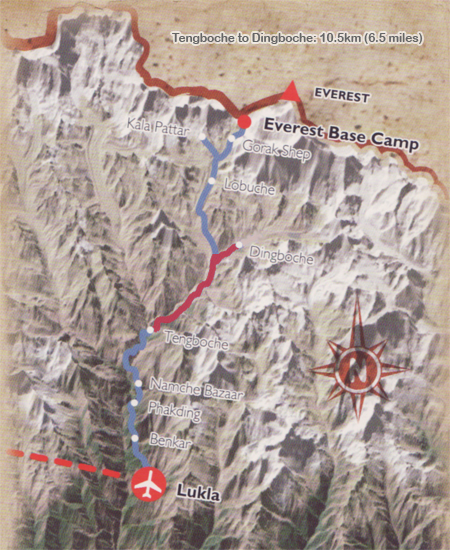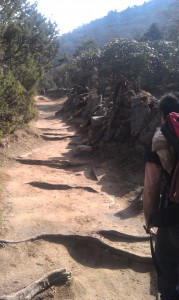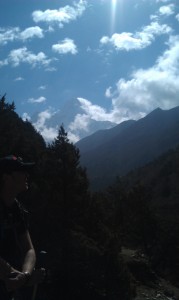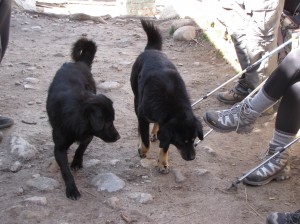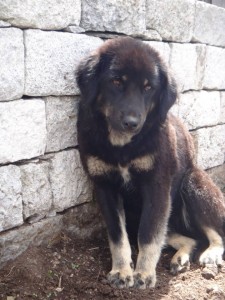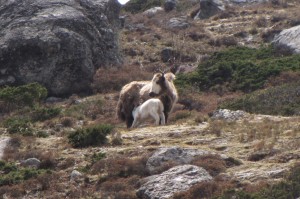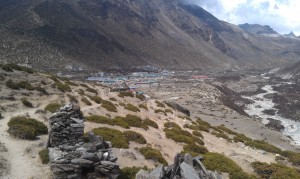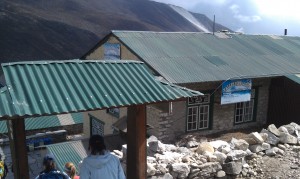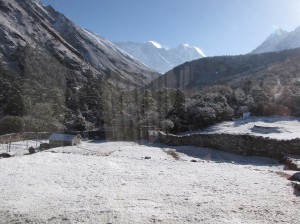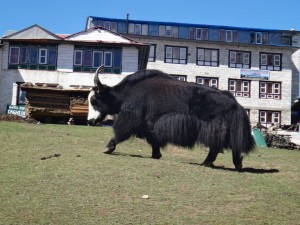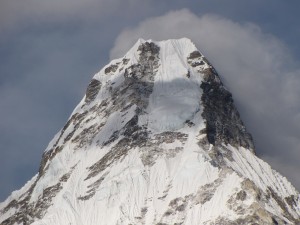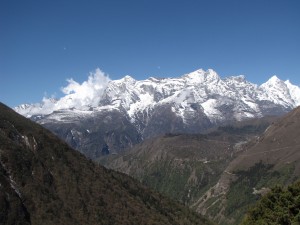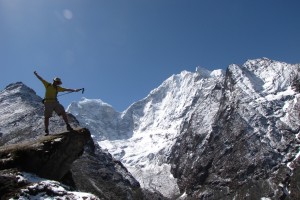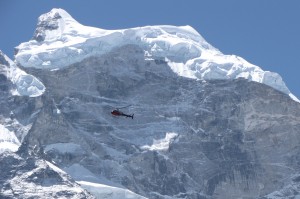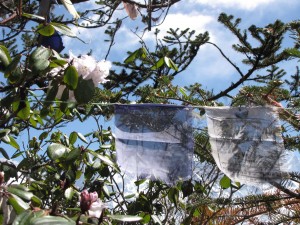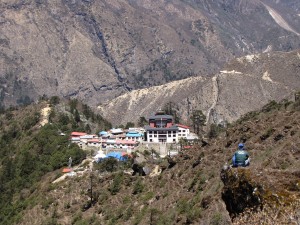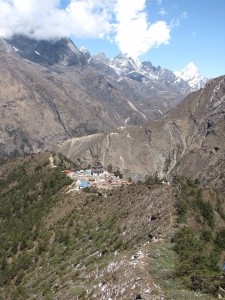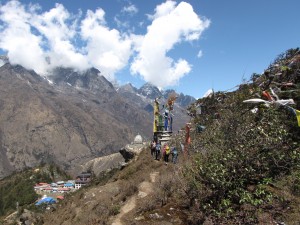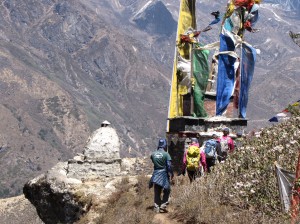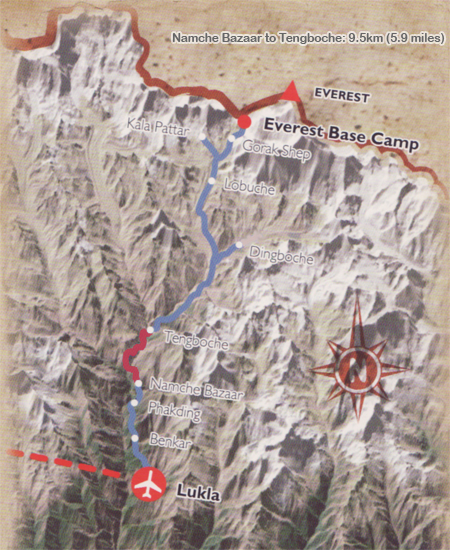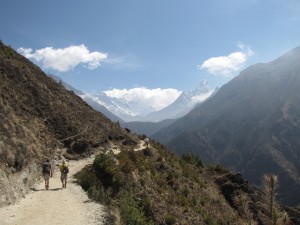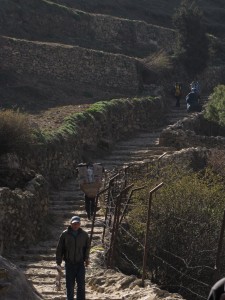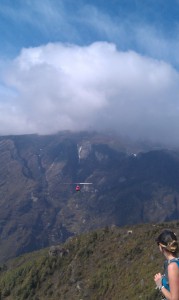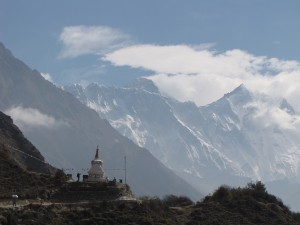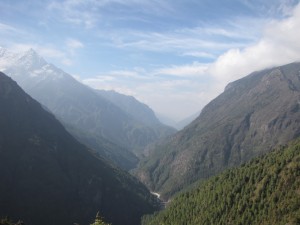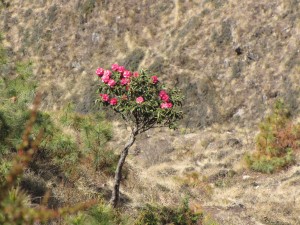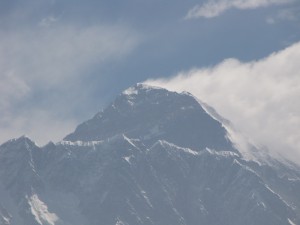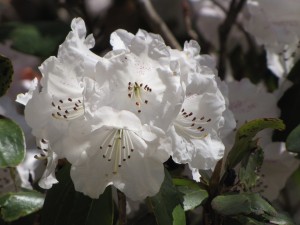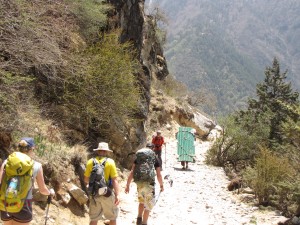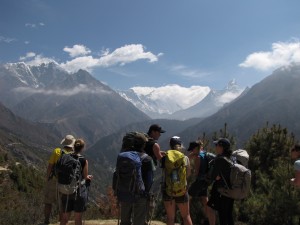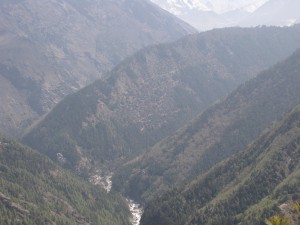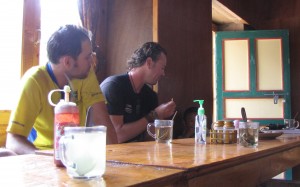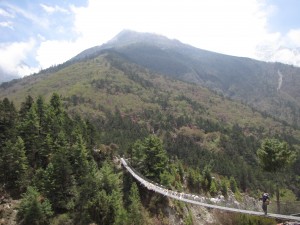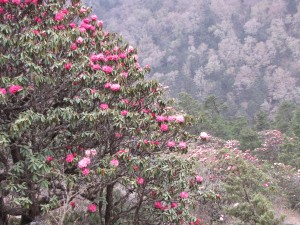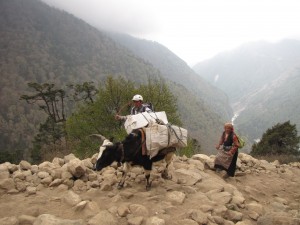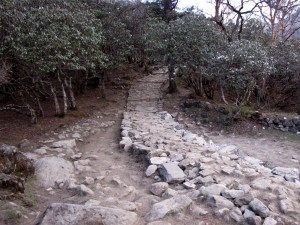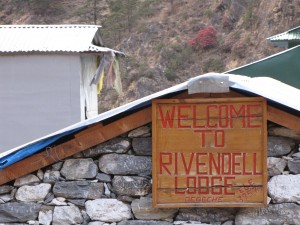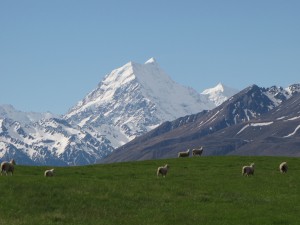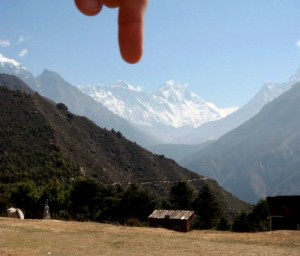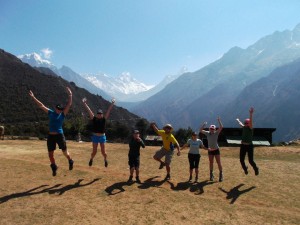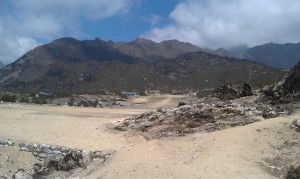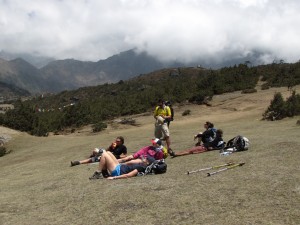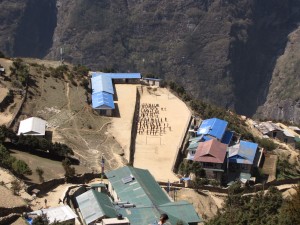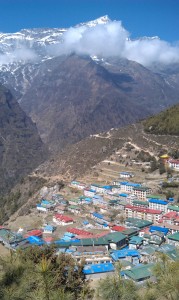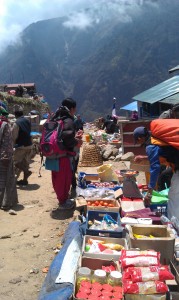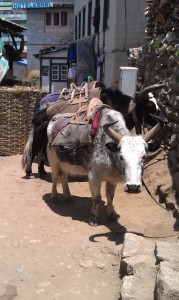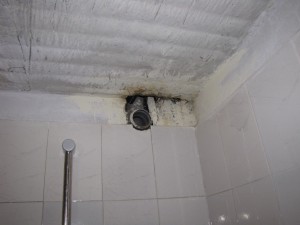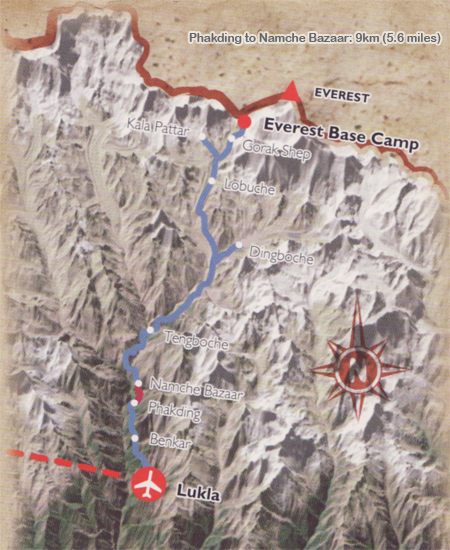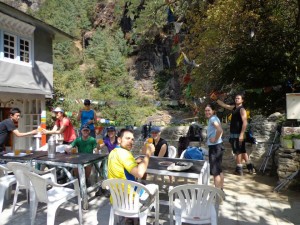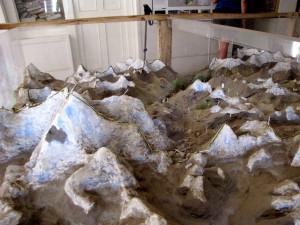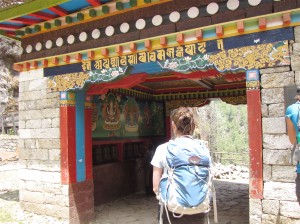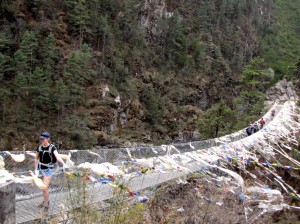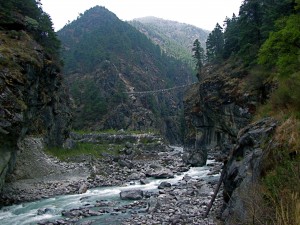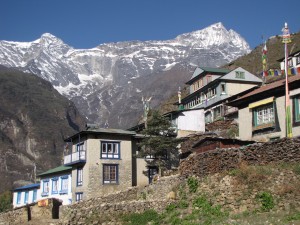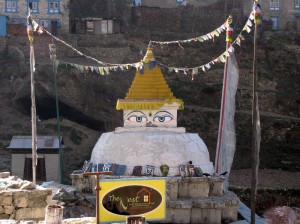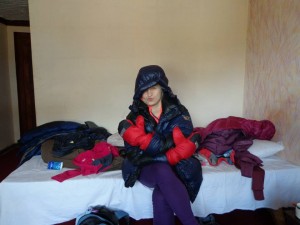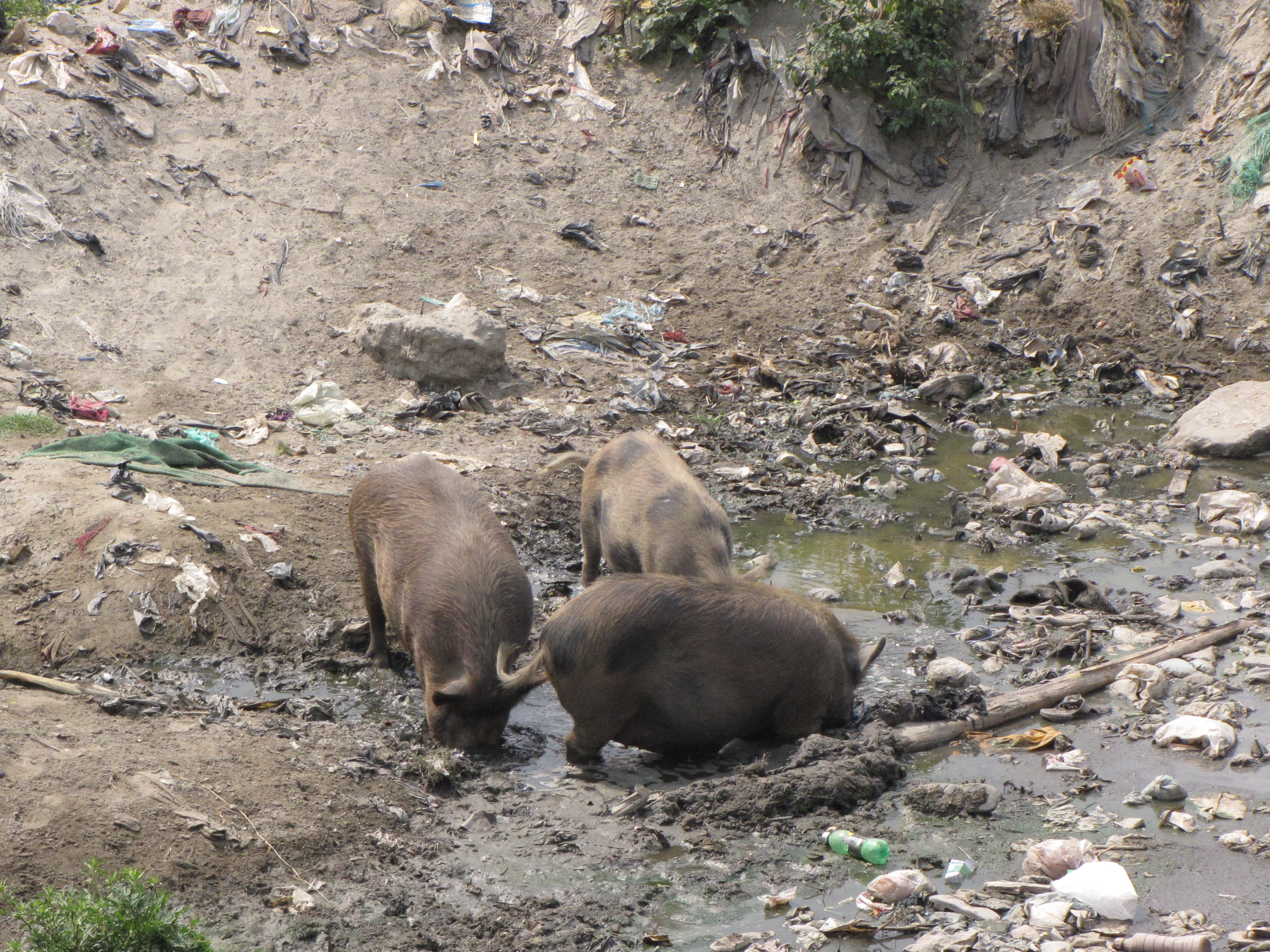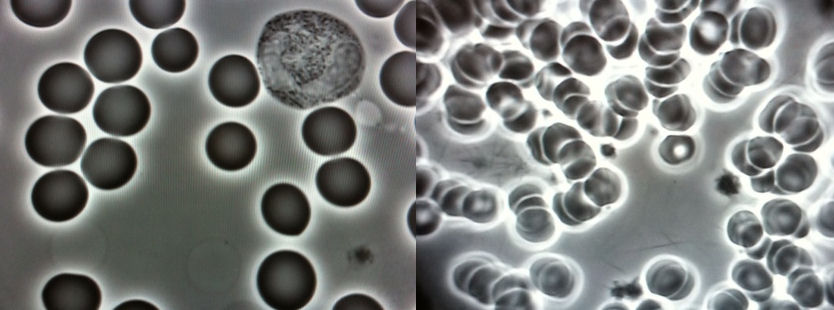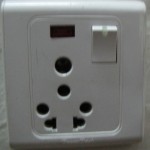We said goodbye to Rivendell and continued on a beautiful prayer stone lined walk along the Imja Khola River. It wasn’t long before we came to a typical Asian style public composting toilet, which a few of us had to use already due to altitude and morning tea. We walked up stone steps to a wooden structure with a thin fabric curtain, probably an old sheet, for a doorway. Inside, the wood floor had a square hole in the bottom and a pile of pine needles for compost. Once in view of the deposits at the bottom of the hole, it became a real test of faith in the wooden floorboards to go ahead and use the toilet rather than flee the structure to find a tree. The great outdoors can be kinder on men in situations like these.
The walk down to the river reminded me of Northern California with its evergreen trees and ferns. We crossed a suspension bridge and headed back up hill. Soon we were above the tree line. By this point, we had picked up our first pet of the day. One of the world’s cutest dogs decided to accompany us on the trail and Dovile named him Fernando.
Fernando followed us to our first tea stop, where we were joined by his doppelganger, whom Kevin dubbed Fernandbro. We enjoyed hot lemon and watched some builders working on a roof. I doubted there was much in the way of building codes and inspections, yet they were obviously building this structure to last. On the way down we passed stone cutters working on the same project, patiently chipping their stone building blocks by hand.
“Did you know Chuck Norris is the only man who can build a house from the roof down?” said K-Fed, master of all Chuck Norris facts.
My favorite was; “When Chuck Norris goes swimming, he doesn’t get wet, the water gets Chuck Norrissed!”
At lunch we were treated to our first hot mango. Wow, where had that been all my life? I loved the hot lemon already, and the hot mango was just as good if not better.
We continued climbing and paused in front of a shop. DK disappeared inside and came out with some yak cheese to pass around. This was our first opportunity to taste it on its own, versus cooked in with lunch or dinner. The taste reminded me of parmesan, the texture of cheddar. Either way, it was delicious. I didn’t say no to seconds.
It was about this point that Fernando and Fernandbro were bullied back down the hill by another dog looking after his territory. Should we interfere and come to their rescue? We considered it, and decided to let the dogs settle it on their own and continued on, sans pets.
The landscape was getting very barren and rocky. We passed a few baby yaks with their protective mothers. On a water break as I was adding more ginger and ginkgo tincture to my canteen, Ele told me more about her dad the naturopath. He sounded like a really cool guy, which explained why she was a really cool chick. The conversation inspired me to continue my studies on the subject and work towards a certification, regardless of what I end up doing with it.
The porters returned from Dingboche to take some of our day packs. None of us really needed help at this point, and were hesitant to burden the boys further. DK explained that they would be offended if we didn’t let them carry. He told a story later about a man in Kathmandu who was deeply offended when someone suggested they deliver a new refrigerator with a truck. “That’s my job.” he insisted before he strapped it on his back and hauled it away. Well then, what the heck? I handed mine over.
We climbed up the rocky hillside along the river towards Dingboche. The elevation on the trail was around 14,000 ft. / 4,270 m, yet the sun was out and we were moving so I was perfectly content to wear a t-shirt. We were getting high enough now that DK was starting his more permanent transition in guiding style from friend to parent. He touched my exposed arm to make sure I wasn’t lying about not being cold and commented that I run pretty hot for a California girl.
“Do I?” I reflected. I knew I ran hot, but really had few people to compare myself to. He’d probably hiked with more California girls than I had. True to Kiwi form, DK and Ele almost always wore shorts. I would keep reminding them that I just dressed in reverse. My black waterproof, windproof pants were what helped keep my top half warm.
We arrived at our home for the next two nights, the Valley View Lodge in Dingboche (14,800 ft. / 4,530 m). From tonight on we’d be sleeping higher than Mt. Whitney (14,505 ft. / 4,421 m).
DK and Sudip set up their own water filter and began topping everyone off. We would take double precaution to keep everyone healthy with the filtered water (filter-ko paani), boiled water (umaleko paani) and the tablets the next few days.
We checked into our rooms and then hung out in the common room. DK knew the drill. He made a beeline for a corner seat and made himself a cozy little nest with one of the big heavy tea house blankets, a pair of the handmade knit socks we saw for sale everywhere down below, and a book. I was a bit envious of the socks and made a mental note to pick some up later. Sudip had a pair of downy slippers I wouldn’t have minded having either. Once the sun went down, it was actually a bit chilly at this place. I might have even partially zipped my expedition weight sleeping bag that night. I debuted my fluffy pink winter hat, and would seldom take it off the next few days, if not to keep warm, then to cover my greasy hair.
To change up the card game routine, a few of us played Hearts before dinner. Afterwards we just read.
“I have the universe all to myself. The universe has me all to itself,” Mattheissen (279). It was a pleasant thought.

